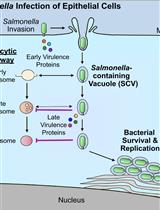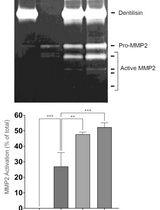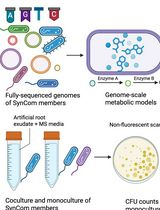- EN - English
- CN - 中文
Live-cell Imaging of Neisseria meningitidis Microcolony Dispersal Induced by Lactate or Other Molecules
乳酸盐或其他分子诱导的脑膜炎奈瑟氏菌小菌落扩散的活细胞成像
发布: 2018年01月20日第8卷第2期 DOI: 10.21769/BioProtoc.2695 浏览次数: 5663
评审: Darrell CockburnTimo LehtiAnonymous reviewer(s)

相关实验方案

细菌病原体介导的宿主向溶酶体运输的抑制:基于荧光显微镜的DQ-Red BSA分析
Mădălina Mocăniță [...] Vanessa M. D'Costa
2024年03月05日 2385 阅读

通过制备连续聚丙烯酰胺凝胶电泳和凝胶酶谱分析法纯化来自梭状龋齿螺旋体的天然Dentilisin复合物及其功能分析
Pachiyappan Kamarajan [...] Yvonne L. Kapila
2024年04月05日 1602 阅读
Abstract
To efficiently colonize the nasopharyngeal epithelium, the human restricted pathogen Neisseria meningitidis follows a multistep adhesion cascade. First, the bacteria adhere to host cells and aggregate into spherical shaped structures called microcolonies. Several hours later, single bacteria start dispersing from the microcolonies and form a monolayer on top of the host cells. Once in proximity to host cells meningococci can adhere tightly to the epithelial surface or become internalized. This can eventually result in invasion of the mucosal surfaces and gain access to the bloodstream, causing a life-threatening disease. Lactate, a metabolite derived from human epithelial cells, has been previously shown to induce rapid dispersal of N. meningitidis from microcolonies. Here, we describe a host-cell free method based on live-cell imaging to examine the effect of host derived lactate on the timing of N. meningitides microcolony dispersal. Although in this protocol we use lactate, it can be easily modified to test the effects of other molecules.
Keywords: Neisseria (奈瑟氏菌)Background
N. meningitidis is an obligate human pathogen that is responsible for septicemia and/or meningitis. Initial attachment to the nasopharyngeal epithelium and subsequent formation of microcolonies are the first steps in the establishment of infection. In order to cause a disease N. meningitidis must cross the epithelial barrier in the nasopharyngeal mucosa, its natural reservoir, and enter the bloodstream (Stephens, 2009; Trivedi et al., 2011). Dispersal of bacteria from microcolonies plays an important role in progression to an invasive disease as it allows the bacteria to come in close contact with the host epithelium (Pujol et al., 1997 and 1999). Despite its importance, not much is known about the underlying mechanism that governs neisserial detachment from the microcolonies. Recently, we reported that lactate, a common metabolite produced and released from human host cells, is involved in inducing microcolony dispersal (Sigurlásdóttir et al., 2017). Here, we provide a step by step method adapted from Sigurlásdóttir et al. (2017) that can be used to examine the effect of small molecules on N. meningitidis microcolony dispersal in a host-cell free manner by time-lapse imaging. In the described method the focus is to examine microcolony dispersal after addition of lactate, however the effect of other molecules derived from the host or the microbiota can also be tested.
Materials and Reagents
- Glass bottom 24-well cell culture plates (MatTek, catalog number: P24G-1.5-13-F )
- Sterile plastic loops
1 µl plastic loops (SARSTEDT, catalog number: 86.1567.050 )
10 µl plastic loops (SARSTEDT, catalog number: 86.1562.050 )
- Falcon tubes
15 ml Falcon tubes (SARSTEDT, catalog number: 62.554.502 )
50 ml Falcon tubes (SARSTEDT, catalog number: 62.547.254 )
- Pipette tips
0.1-10 µl capacity (SARSTEDT, catalog number: 70.1130.100 )
20-200 µl capacity (SARSTEDT, catalog number: 70.760.502 )
50-1,000 µl capacity (SARSTEDT, catalog number: 70.762.100 )
- Bacteriological Petri plates (SARSTEDT, catalog number: 82.1473 )
- 5-µm pore filter (VWR, catalog number: 514-4106 )
- 5 ml syringe (VWR, catalog number: 613-3940 )
- Serological pipettes
5 ml pipette (SARSTEDT, catalog number: 86.1253.001 )
25 ml pipette (SARSTEDT, catalog number: 86.1685.001 )
- 250 ml vacuum filtration unit, 0.22 μm (SARSTEDT, catalog number: 83.1822.001 )
- Bacterial strain: Neisseria meningitidis serogroup C strain FAM20 (Rahman et al., 1997). FAM20 is a nalidixic acid-resistant mutant of FAM18 (ATCC, catalog number: 700532 )
Note: The bacterial stock is stored in 25% glycerol at -80 °C.
- Glycerol (Sigma-Aldrich, catalog number: G5516 )
- GC agar (NEOGEN, catalog number: 7104A )
- D-glucose (Sigma-Aldrich, catalog number: G8270 )
- L-glutamine (Sigma-Aldrich, catalog number: G8540 )
- Ferric(III) nitrate nonahydrate (FeNO3·9H2O) (Sigma-Aldrich, catalog number: F3002 )
Note: This product has been discontinued.
- Cocarboxylase (Sigma-Aldrich, catalog number: C8754 )
- DMEM, no glucose, no glutamine, no phenol red (Thermo Fisher Scientific, GibcoTM, catalog number: A1443001 )
- GlutaMAXTM Supplement (Thermo Fisher Scientific, GibcoTM, catalog number: 35050038 )
- Sodium pyruvate (Thermo Fisher Scientific, catalog number: 11360039 )
- Fetal bovine serum (FBS), heat inactivated (Sigma-Aldrich, catalog number: F9665 )
- Sodium L-lactate (Sigma-Aldrich, catalog number: L7022 )
- Sodium D-lactate (Sigma-Aldrich, catalog number: 71716 )
- GC agar plates (see Recipes)
- 0.2% Cocarboxylase solution (see Recipes)
- Kellogg’s supplement (see Recipes)
- 2.5 mM glucose (see Recipes)
- DMEM (see Recipes)
- DMEM/1%FBS (see Recipes)
- Lactate solutions (see Recipes)
Equipment
- Class II biosafety cabinet (e.g., Esco Micro, model: Airstream® Class II Biological Safety Cabinet )
- Humidified 5% CO2 incubator at 37 °C (e.g., Thermo Fisher Scientific, Thermo ScientificTM, model: HeracellTM 150i )
- Water bath set to 37 °C (e.g., Grant Instruments, model: SAP12 )
- Spectrophotometer (e.g., Bio-Rad Laboratories, model: SmartSpec Plus )
- Inverted live-cell observer, connected to an incubator with a controlled temperature (temperature module) and CO2 module (e.g., Carl Zeiss, model: Axio Observer Z1 )
- Pipette boy (e.g., Fisher Scientific, model: FisherbrandTM Electric Pipet Controller )
- Pipettes
0.5-10 µl capacity (e.g., Eppendorf, catalog number: 4924000029 )
10-100 µl capacity (e.g., Eppendorf, catalog number: 4924000053 )
100-1,000 µl capacity (e.g., Eppendorf, catalog number: 4924000088 )
- 1 L bottle
- 500 ml flask
Software
- AxioVision (Release: 4.8.2 SP3)
- Fiji (http://fiji.sc/; version: ImageJ 2.0.0-rc-44/1.50e)
- Microsoft Excel
Procedure
文章信息
版权信息
© 2018 The Authors; exclusive licensee Bio-protocol LLC.
如何引用
Sigurlásdóttir, S., Eriksson, O. S., Eriksson, J. and Jonsson, A. (2018). Live-cell Imaging of Neisseria meningitidis Microcolony Dispersal Induced by Lactate or Other Molecules. Bio-protocol 8(2): e2695. DOI: 10.21769/BioProtoc.2695.
分类
微生物学 > 微生物-宿主相互作用 > 细菌
微生物学 > 微生物细胞生物学 > 细胞成像
细胞生物学 > 细胞成像 > 活细胞成像
您对这篇实验方法有问题吗?
在此处发布您的问题,我们将邀请本文作者来回答。同时,我们会将您的问题发布到Bio-protocol Exchange,以便寻求社区成员的帮助。
提问指南
+ 问题描述
写下详细的问题描述,包括所有有助于他人回答您问题的信息(例如实验过程、条件和相关图像等)。
Share
Bluesky
X
Copy link









